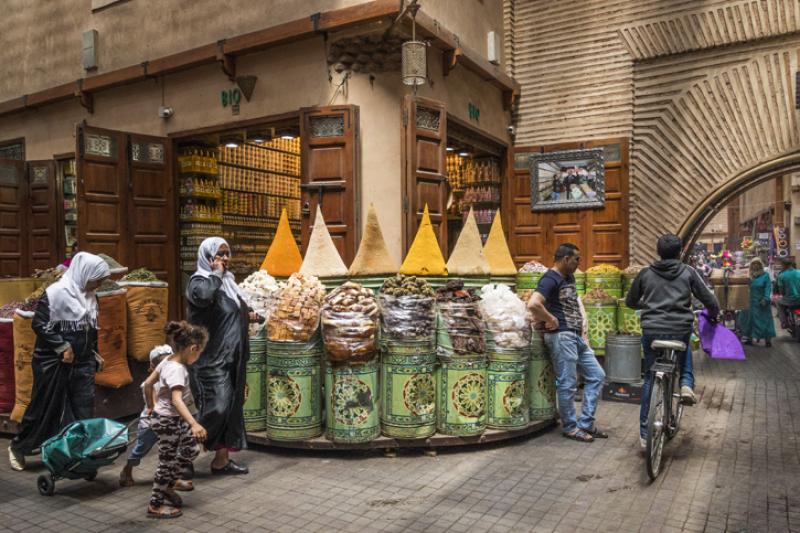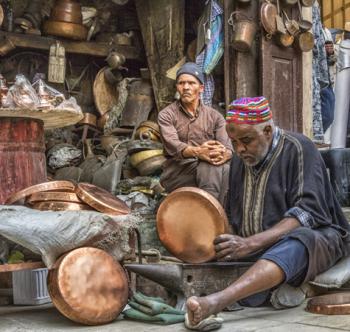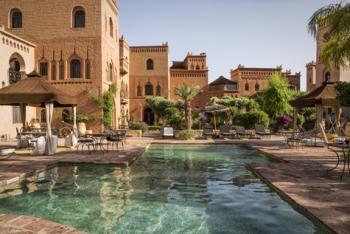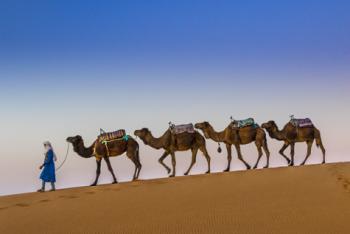Making memories in Morocco
This article appears on page 6 of the October 2018 issue.
In May 2018, I joined nine other travelers, along with our tour leader (and professional photographer), Daniel, our local guide, Ali, and our driver, Abdul, on a photography tour of Morocco.
What sets a photography tour apart from a regular tour? Being given the opportunity to rise before dawn to capture the sunrise; setting up tripods during the "blue hour" after sunset, and getting up in the middle of the night to photograph the Milky Way, among other things.
Although not everyone in our group was an avid photographer, we all enjoyed the fact that our guide, Ali Atami, could use his 20 years of guiding expertise to introduce us to people and places we would otherwise not have been able to experience, and we had Daniel to help us make the most of the opportunity.
Some of my friends questioned the safety of going to Morocco. I can tell you that not only did I find the country to be safe, its people were very welcoming. When locals learned I was from the US, the first thing they would say was, "Morocco was the first country to recognize the US after the Revolutionary War."
Tourism is the third-largest industry there after agriculture and mining, and the infrastructure was excellent. The cities were clean; the roads were good; the terrain was varied; the hotels we stayed in were elegant and charming, and the food was delicious.
Getting there
I arrived in Casablanca for the start of my 14-day photo journey after an overnight in Madrid. There were no direct flights from Atlanta to Morocco. I had a choice of connecting in New York, Amsterdam, Paris, Lisbon or Madrid.
I wanted to fly business class, so I checked prices for every route combination I could think of. I also contacted several of the online companies that promise considerable discounts for business airfare, but none of them was able to come close to the deal I found on my own.
I flew round trip from Atlanta to Madrid on Delta Air Lines for $2,833. Then I used my British Airways Avios points (plus $260 for fees) to secure discounted business-class flights on Iberia to and from Morocco.
My flight to Madrid was scheduled to land at 8:35 a.m., and the Iberia flight to Casablanca would depart at 10:45. I was afraid that I would not have enough time to go through Customs, change terminals, go through security again and make my flight to Morocco within two hours. What if my flight to Madrid was a little late? So I opted to fly in a day early, staying the night at the Madrid airport Hilton and spending the day sightseeing in the city.
However, after all that planning, I very nearly missed my flight to Morocco anyway! The front desk clerk at the Hilton became my hero. The earplugs I used that night in the hotel to block the noise of children playing soccer outside my window also kept me from hearing either of the two alarm clocks I had set for 7:00 the next morning. When I awoke and saw the clock said 9:10, I couldn't believe it. I was supposed to start boarding in 35 minutes!
I threw all my clothes into my suitcase, not bothering to brush my hair or my teeth, then raced downstairs and explained my predicament. The desk clerk commandeered a van that was dropping off airline personnel at the hotel and told the driver to take me straight to the airport.
I arrived there at 9:20 and started to make my way through security when the next barrier appeared. The security machines would not accept the boarding pass on my cell phone.
Can you picture a 71-year-old woman with a backpack on and pulling her wheeled suitcase running full speed through an airport?
Finally, with a printed boarding pass in hand, I ran back, waded through security, took three escalators down to the train, traveled to the appropriate terminal, took three more escalators up and then ran through the entire duty-free shopping area to reach my gate.
But I made it! And people wonder why I travel with carry-on luggage only.
Orientation
After settling into my room at Hotel Park Suites in Casablanca, I attended the info session that our tour leader held that first afternoon.
We each were given a packet with printed information, luggage tags, souvenirs and a small leather change purse. Ali explained that small coins could be hard to come by in Morocco but that we would need them for paying bathroom attendants. The company had stockpiled coins so we could change some of our paper money then and there; our coin purses were filled with these coins.
Sure enough, many public bathrooms, even in restaurants, had attendants who handed out toilet paper in exchange for a small contribution.
Dinner on our first night was at a restaurant specializing in international cuisine. When some of us wondered why we weren't sampling traditional Moroccan food, we were assured we would get plenty of exposure to local dishes. That proved to be the case, and I must say that the food in Morocco was uniformly excellent. Tagines and kabobs are specialties, along with a wide variety of fresh fruits and vegetables.
The French ruled parts of Morocco from 1912 to 1956, and French influence could be seen in the wonderful pastries that were served. Many of the people we met also spoke French, and many signs were in French as well as Arabic.
Morocco is a predominantly Muslim country, and some of the restaurants do not serve any alcohol, but many do, especially in the tourist areas. In fact, Morocco has vineyards and produces both red and white wines as well as beer. I found some of the local red wines to be very pleasant, although the white was rather bland.
What to wear as a woman traveling in Morocco? Most of the women there do wear traditional long gowns and head scarves. However, they are fashionistas! Beautiful fabrics, bright colors and floral and animal prints abound. Now and then a woman with uncovered hair would be seen hand in hand with another woman wearing her hijab.
I did not cover my hair, but I did take care not to wear sleeveless shirts or skin-tight clothing. I wore my ScotteVEST every day along with a T-shirt and either slacks or a long skirt. It was never particularly hot, even in the desert, although we were told it gets very hot in midsummer.
Hitting the road
The chief attraction in Casablanca was the magnificent Hassan II Mosque, the largest in Morocco. Some of us got up to photograph it at sunrise, and later we had a private tour inside the ornate building. That night we returned to see the mosque lit up against the deep-blue night sky.
Our travel through Morocco was in a van that seated 16 plus the driver and guide, so there were always a few empty seats. We played musical chairs, trying to photograph the scenery as we motored from place to place.
Our first stop was Rabat, the capital, where we toured the ruins of Chellah, a medieval fortified necropolis built on the ruins of an even more ancient Roman settlement. Storks had made the place their home, with their huge nests resting on the crumbling walls and on top of the tiled minaret.
The next city on our list was Chefchaouen, in the northern part of the country. Known as the Blue City due to the color of the buildings, it is a UNESCO World Heritage Site and a top tourist draw.
We had to leave the van outside the city walls and hike up the narrow streets to our beautiful inn, the Riad Cherifa. Every room was meticulously decorated in a unique way, and we made a tour of each other's intricately tiled bathrooms. This was one of the most beautiful inns I have ever stayed at, anywhere.
Chefchaouen, itself, was quite beautiful, with narrow, stair-studded alleys and creatively painted doorways. Shops lined the main streets.
Morocco is only a 70-minute ferry ride from Spain, so weekends were especially crowded with visitors. I found that getting up early and venturing out before breakfast gave me quiet time to take photographs before the hordes descended.
In the afternoon we had free time, so I decided to try out the hammam at the riad. The hotel clerk called it a massage, but it was not. It was a hot steam bath, with a female attendant who vigorously scrubbed my body from head to toe with a rough cloth, soap and herbs.
I was glad I tried out this traditional Moroccan cleansing ritual, but I found it rather harsh on my skin and uncomfortably hot. The cost was about $30.
On to Fes
Much of the terrain of Morocco looks nothing like the sunbaked desert of movie lore. On our way to our next city, Fes, we traversed lush green valleys, pastures of sheep and colorful markets. Donkeys were everywhere — being ridden, pulling carts and piled high with merchandise for sale.
Fes is the cultural capital of Morocco, and we had the privilege of visiting a number of factories and markets. First, we were given a tour of a pottery factory, where we saw the process of making exquisite mosaics and hand-painted dishes from start to finish.
In Fes, we stayed at Riad El Yacout, an inn composed of two former mansions that are now connected.
Fes is renowned for its medina, a walled inner part of the city with a warren of alleys filled with individual stalls selling every type of goods and crafts, from food to silk, copper and leather.
Even our guide, who has been traversing these alleys for 20 years, admitted he did not know every corner of the maze. He did know many of the vendors, however, and was able to convince them to let us photograph them going about their work.
We frequently had to squeeze against the walls as workers moved their donkeys and mules through the narrow passages. Amazingly, the streets were quite clean and not covered with manure.
That afternoon, we had a special photography session at El Glaoui Palace. Our guide's niece and a friend, dressed in elaborate, traditional costumes, posed for us amid the beautiful tiled walls and stained-glass windows of the palace.
My favorite activity, though, was visiting the tannery the next day, where we were able to watch and photograph the workers as they dyed and dried leather hides that would be fashioned into purses, ottomans and shoes. The men actually climbed into the vats of dye and massaged the leather with their feet.
Next we visited a rug store, where we were treated to a display of the beautiful, handwoven rugs. Our guide warned us that we needed to seriously bargain if we were going to buy something.
We also visited a weaver and learned to tie turbans with the long cotton and silk scarves. (Cotton scarves cost $4 and silk ones only $7.)
We also visited the Jewish quarter, where we learned that both Muslims and Jews had escaped the Spanish Inquisition by emigrating to Morocco at the same time.
Leaving Fes, we traversed the Middle Atlas Mountains, which offered views of jagged rock faces and beautiful forests. On the way, we passed through the Parc National d'Ifrane, where a troupe of endangered Barbary macaques lives. The adults were cradling tiny babies and seemed to have no fear of humans. What a photo opportunity this was!
The population of Morocco is actually 40% Berber, a people who were there before the Arabs came. As we were traveling through Berber country we stopped to visit a nomad family, who allowed us to photograph their home.
I was fascinated by the multicolored patchwork tent with a solar panel that produced enough electricity for a small TV. We saw numerous solar-panel installations throughout the country, as Morocco is a leader in expanding the use of solar energy.
Once again, it was through the auspices of our guide that we were able to meet these charming people.
Into the desert
Leaving the mountains behind, we arrived in Erfoud, where we transferred to 4x4 vehicles and headed out into the Sahara. We stayed at Auberge les Dunes D'Or, a luxurious, all-inclusive complex of buildings in the desert.
The next morning, some of us arose before dawn to photograph the dunes at sunrise. One of the staff obligingly led a short camel train back and forth across the dunes to add context to our photos.
We thought there would be an optional visit to a village in this area, but it turned out that the locals were not willing to allow visitors into their homes or tents and were not keen on photography, so we rested during the heat of the afternoon and prepared for what was, to me, the highlight of the trip: a camel trek and an overnight in the desert.
While four members of the group decided to stay at the auberge and take advantage of its pool and spa, the rest of us mounted our camels and set off for a 2-hour ride into the dunes. We stopped along the way to photograph the sunset and arrived at the camp of Berber tents after dark.
After a dinner cooked out in the open and a drum serenade by the staff, we bedded down in our individual tents. A separate tent served as the WC, with flush toilets and a sink.
I didn't find riding a camel to be that much different from riding horseback. As the smallest person in the group, I got the smallest camel, who was apparently "in training." While the other camels all waited to be told to get up and down for riders to mount and dismount, mine was not as disciplined. I learned quickly to anticipate his movements, leaning back and forward to balance his motion, as he frequently jumped the gun.
One of my hopes on this trip was to take advantage of the remote location to photograph the night sky. Would you believe that the desert sky was half full of clouds that night? Nevertheless, four of us awoke at 4 a.m. to see if we could find the Milky Way.
We tiptoed out of the camp to set up our tripods, and I knelt on the sand. It was a little bumpy, and I discovered the next morning that the lumps were camel dung. Still, even with a few clouds, the night sky was magnificent.
After our desert adventure, the next stop was Dadès, where we spent the night at Hotel Xaluca Dades. Then we went on to Ouarzazate, the "Hollywood" of Morocco, where many movies are filmed. We had fun in the museum there, where movie sets including dungeons, throne rooms and exotic gardens were on display.
We stayed at the Ksar Ighnda, a luxurious resort with beautiful terraces and gardens.
The next morning we visited the famous Kasbah Ait-Ben-Haddou, another UNESCO site. An outstanding example of an ancient adobe, fortified town, it is still inhabited by several families, although most of the local people now live in more modern dwellings. Many films have been shot there, including "Gladiator" and "The Last Temptation of Christ."
Marrakech
On our way to Marrakech, the last city on our tour, we drove over the High Atlas Mountains. The road, a spectacular engineering feat that was built by the French military from 1929 to 1936, traverses the Col du Tichka, the highest major mountain pass in North Africa, at over 7,400 feet.
In Marrakech, we stayed at Ryad Art Place, a sumptuous hotel in the medina. This market was different from anything we had yet seen in Morocco. A large open area, surrounded by market stalls and restaurants, was filled to overflowing with tourists, vendors and buskers.
Musicians, horse-drawn carriages, snake charmers, henna-tattoo artists and women with baskets of goods balanced on their heads vied for the attention of tourists dressed in everything from full veil to bare shoulders and shorts.
Grandmothers with baby carriages, young men on motorbikes, and mule-drawn carts threaded their way through the throngs. And everywhere, aggressive hustlers were asking for money if you showed any sign of wanting to take a photograph or watch the show. It was a zoo!
Things calmed down a little the next day as we visited the Majorelle Garden, a lush garden with terra-cotta, yellow and cobalt-blue structures. Begun in 1923, it was restored by Yves Saint-Laurent and his partner in the 1980s. It now houses a Berber museum as well.
We also visited a Berber pharmacy, where we were able to purchase small bags of Moroccan spice blends. We had admired the colorful displays of spices in the open markets but weren't sure of their purity. Ali also accompanied several of us who wanted to find reputable merchants for other goods.
That morning, a few of the group members continued on for an additional 3-day excursion to Essaouira. I opted to fly back to Madrid, spending two days there before flying home. I have to admit, I preferred the food in Morocco. In fact, I am looking now for a good Moroccan cookbook.
The cost for my 14-day adventure was $6,490, which included a $1,000 single supplement, as my husband did not make this trip. This included all accommodations, all but two meals, all entrance fees and all tips, fees and transportation within Morocco, except for tips for our guide and driver.
I booked the trip with Darlene Hildebrandt through her photography-specific website, www.digitalphotomentor.com.
Except for the one in Casablanca, which was just OK, all the hotels were very comfortable and elegant, and I would definitely recommend them.
It is hard to imagine a better guide than Ali Alami. Darlene Hildebrandt arranges this tour annually as well as photo tours to other countries. I hope to take another of these in the future.





